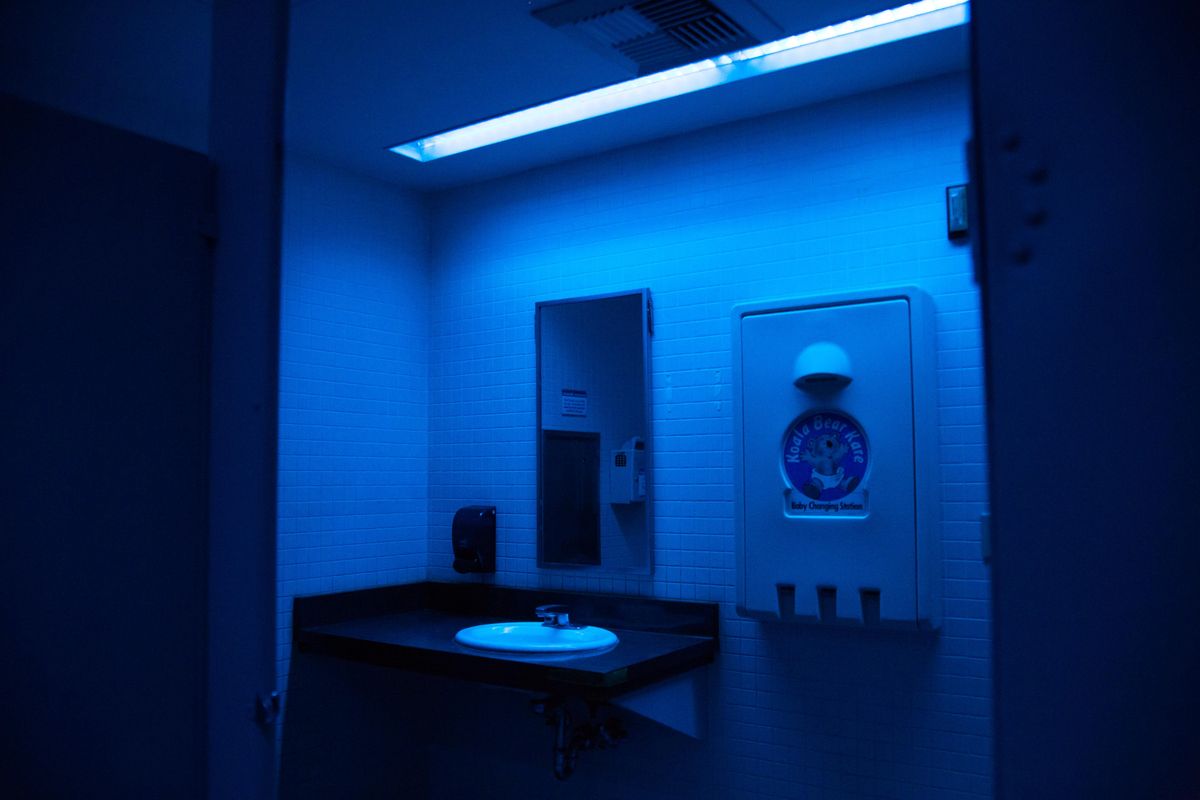Downtown Spokane library installs blue lights in bathrooms to deter drug use

On a typical day in the Spokane Public Library, a custodian could be greeted by blood in bathroom stalls, needles in the toilets and paper towels spread everywhere.
Now library leaders are trying to put a stop to it by installing blue lighting in the men’s public restrooms, which are designed to make needle injections more difficult. So far, it seems to be working as evidence of drug use has decreased.
The blue lights make it more difficult for drug users to find a vein.
Researchers, however, say using blue lighting could lead to injuries in drug users, or spread disease.
Library Director Andrew Chanse said increased drug use in the bathroom is just one symptom of a larger opioid epidemic. He said the library already has installed safe needle disposal containers in public bathrooms, but people were still flushing used needles or leaving them in toilet paper dispensers.
“We’re really just looking for a solution to stop that from happening in our facilities,” he said.
Before the lights were installed, spokeswoman Amanda Donovan said the library was paying about $400 twice a week to fix plumbing issues caused by needles flushed down the toilets. She said the library hasn’t had another incident since the lights, which cost about $10 a bulb, went up.
She said that to date, there have not been any overdoses and no patrons or employees have reported injuries due to needles, but the library restrooms need to be safe for the employees who clean them and the patrons who use them.
“We have sympathy for those who suffer from addiction,” she said, “but not at the expense of the safety of children and employees.”
City spokeswoman Marlene Feist said the city has not looked into using blue lights in any other public bathrooms.
According to data from a Spokane Regional Health District report, in 2014 about 1.7 percent of adults said they used opioids in the last 30 days. A health district study of Spokane County high school students in 2016 found that 4.9 percent, or 1 in 20, had used opioids in the last 30 days.
Michael McDonell, a Washington State University medical school professor and researcher who has studied drug treatment and mental illness, said the small amount of research that has been done on blue lights shows that many drug users still will inject when there are blue lights, even if it puts them in danger.
“Once you’re down that line, that far in your addiction and you have that few options, you’re just going to do whatever you can to get the drug in your body,” he said.
One 2010 study McDonell cited found that out of 31 drug users, 18 were only partially, or not at all deterred by blue lighting.
He said drug users who have been injecting for a long time already struggle to find their veins. Making injection more difficult could cause people to inject multiple times, which can increase their risk of infection, or cause them to leave more blood in a public area.
McDonell said as a parent and a person who uses the public library, he understands why library leadership is looking for ways to deter drug use in their bathrooms, but without a safe injection site, people in desperate situations likely will keep injecting in public bathrooms.
He suggested the library, which hosts a community court to help connect people to housing, mental health and other health care services, put up signs in the bathrooms pointing people to treatment or the Spokane Regional Health District needle exchange program.
The Health District’s needle exchange program provides a one-for-one exchange of needles to prevent the spread of diseases like HIV, hepatitis B and hepatitis C.
According to data from the exchange program, it accepted more than 900,000 needles and exchanged them for almost 950,000 needles in 2016. More than 60 percent of people who used the exchange program said heroin was their preferred drug.
Sterling McPherson, another WSU researcher and addiction expert, said its extremely difficult to find an effective way to deter people from injecting drugs.
He said there are only a couple of studies, which only interview a few dozen people, that provide any data on the effectiveness of using blue lights.
“It would be great if this strategy is effective for the library,” he said, “but based on what we know, which is pretty limited, it’s likely they still are going to use in that restroom, or find a place nearby to use.”
The chair of the Board of Library Trustees, Jim Kershner, said the library’s plumbing bills have gone down since installing the lights, but the library doesn’t want to put in danger drug users who inject despite the blue lights.
“It’s working for this part of the problem,” he said, “but is it creating a different problem? We don’t know yet.”
He said the library is consulting local experts, such as the county’s needle exchange program, to decide whether they should continue using blue lights.